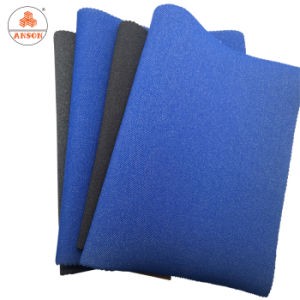Welcome!







High Quality SGS Certification Skidproof Embossed SBR Neoprene (NS-004)
Product Description
The appearance is milky white, beige or light brown flake or block, which is made of chloroprene (i.e., 2-chloro-1,3-butadiene) as the main raw material α- Elastomer produced by polymerization. Chloroprene solubility parameter δ= 9.2~9.41。 It is soluble in toluene, xylene, dichloroethane, and ethylene trivanadate, slightly soluble in acetone, methyl ethyl ketone, ethyl acetate, and cyclohexane, insoluble in n-hexane, solvent gasoline, but soluble in a mixture of good solvent and bad solvent and non-solvent or bad solvent and non-solvent in an appropriate proportion, swelling in vegetable oil and mineral oil without dissolving.

Product application
CR122 neoprene: transmission belt, transport belt, wire and cable, oil-resistant rubber plate, oil-resistant rubber hose, sealing material and other rubber products.
CR232 neoprene: cable sheath, oil-resistant rubber hose, rubber seal, adhesive, etc.
CR2441 2442 neoprene: raw material for adhesive production, used for bonding metal, wood, rubber, leather and other materials.
CR321 322 neoprene: cable, rubber plate, common and oil-resistant rubber hose, oil-resistant rubber boots, wind guide, rain cloth, tent cloth, conveyor belt, conveyor belt, rubber seal, agricultural capsule air cushion, lifeboat, etc. It is used as toughening agent of modified acrylate fast structure adhesive (SGA).

Chloroprene rubber is produced by lotion polymerization, and the production process is mostly single kettle batch polymerization. The polymerization temperature is mostly controlled at 40~60 ℃, and the conversion rate is about 90%. High polymerization temperature, high final conversion or air (oxygen) entering the polymerization process will lead to product quality degradation. The molecular weight is adjusted by sulfur-turrum (tetraalkylmethylaminothiocarbonyl disulfide) system in production. The main disadvantage of sulfur-turam system is that the sulfur bond is not stable enough, which is one of the important reasons affecting the storage. If the molecular weight is adjusted by mercaptan, this performance can be improved. Unlike general synthetic rubber, neoprene is vulcanized with zinc oxide and magnesium oxide instead of sulfur.

Neoprene has a low oxidation rate and can be used in a variety of building applications, including electrical insulation, adhesives and asphalt products. Thick neoprene bearing pads are used in buildings to withstand the pressure of heavy objects and loads. The chemical inertness of neoprene helps it resist the influence of weather, ozone and other outdoor variables, and can withstand petroleum based mixtures such as solvent, oil and grease. Neoprene bearing pads are also used for bridges as safety mechanisms. They give the bridge flexibility to minimize the damage caused by movement. Because neoprene is stable and non-reactive, it can also be used to manufacture corrosion resistant coatings and as a base for adhesives.


Recommended Products
Recently Viewed
 Factory Manufacturer Rubber Padding Chloroprene/Neoprene Rubber Elastomeric Foam
Factory Manufacturer Rubber Padding Chloroprene/Neoprene Rubber Elastomeric Foam New Arrival Rubber Padding Chloroprene/Neoprene Rubber Elastomeric Foam
New Arrival Rubber Padding Chloroprene/Neoprene Rubber Elastomeric Foam New Arrival Rubber Padding Chloroprene/Neoprene Rubber Elastomeric Foam
New Arrival Rubber Padding Chloroprene/Neoprene Rubber Elastomeric Foam Factory Direct Sale 4mm Blue Grey Creamy Magenta Ubl Loop Fabric Neoprene Rubber for Knee Braces
Factory Direct Sale 4mm Blue Grey Creamy Magenta Ubl Loop Fabric Neoprene Rubber for Knee Braces Eco Friendly Industrial Neoprene Rubber Sheet Rubber Mat Gaskets
Eco Friendly Industrial Neoprene Rubber Sheet Rubber Mat Gaskets
Contact Us
Dongguan City Anson Neoprene Fabric Co., Ltd.

